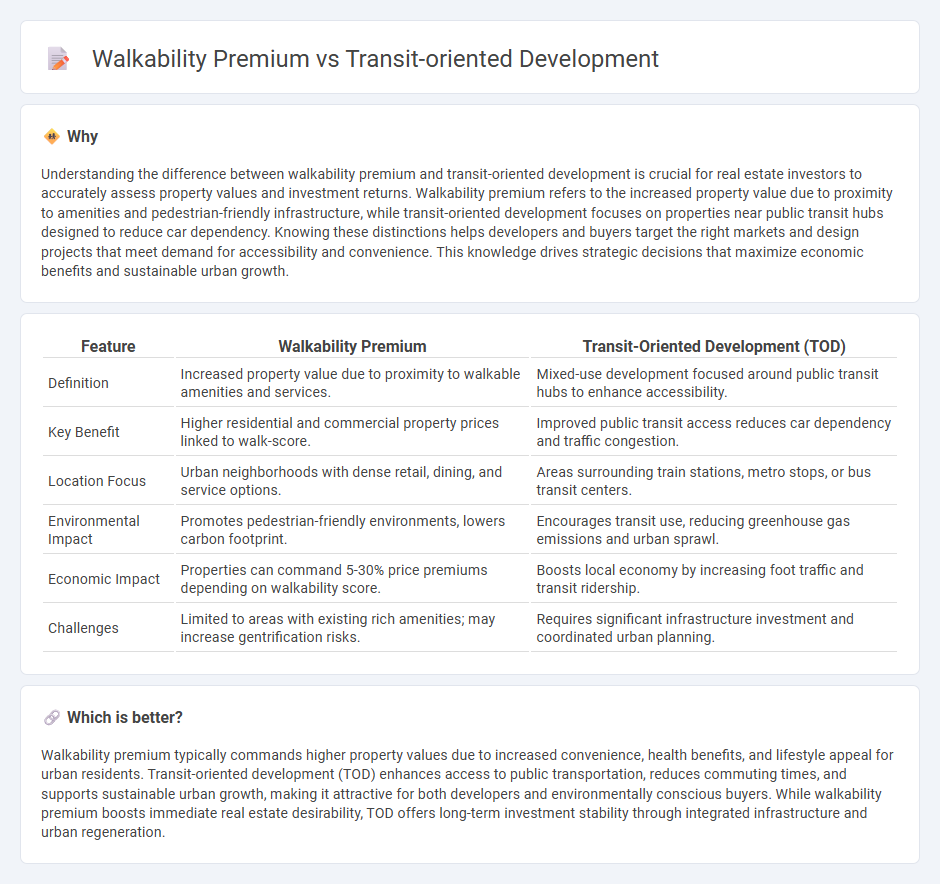
Walkability premium refers to the increased property values and demand in neighborhoods where residents can easily access amenities on foot, enhancing convenience and lifestyle quality. Transit-oriented development (TOD) focuses on creating dense, mixed-use communities centered around high-quality public transit hubs to reduce car dependency and promote sustainable urban living. Explore how walkability premium and TOD strategies reshape urban real estate dynamics and investment opportunities.
Why it is important
Understanding the difference between walkability premium and transit-oriented development is crucial for real estate investors to accurately assess property values and investment returns. Walkability premium refers to the increased property value due to proximity to amenities and pedestrian-friendly infrastructure, while transit-oriented development focuses on properties near public transit hubs designed to reduce car dependency. Knowing these distinctions helps developers and buyers target the right markets and design projects that meet demand for accessibility and convenience. This knowledge drives strategic decisions that maximize economic benefits and sustainable urban growth.
Comparison Table
| Feature | Walkability Premium | Transit-Oriented Development (TOD) |
|---|---|---|
| Definition | Increased property value due to proximity to walkable amenities and services. | Mixed-use development focused around public transit hubs to enhance accessibility. |
| Key Benefit | Higher residential and commercial property prices linked to walk-score. | Improved public transit access reduces car dependency and traffic congestion. |
| Location Focus | Urban neighborhoods with dense retail, dining, and service options. | Areas surrounding train stations, metro stops, or bus transit centers. |
| Environmental Impact | Promotes pedestrian-friendly environments, lowers carbon footprint. | Encourages transit use, reducing greenhouse gas emissions and urban sprawl. |
| Economic Impact | Properties can command 5-30% price premiums depending on walkability score. | Boosts local economy by increasing foot traffic and transit ridership. |
| Challenges | Limited to areas with existing rich amenities; may increase gentrification risks. | Requires significant infrastructure investment and coordinated urban planning. |
Which is better?
Walkability premium typically commands higher property values due to increased convenience, health benefits, and lifestyle appeal for urban residents. Transit-oriented development (TOD) enhances access to public transportation, reduces commuting times, and supports sustainable urban growth, making it attractive for both developers and environmentally conscious buyers. While walkability premium boosts immediate real estate desirability, TOD offers long-term investment stability through integrated infrastructure and urban regeneration.
Connection
Walkability premium significantly boosts property values by enhancing access to amenities and reducing dependence on personal vehicles, attracting buyers and renters seeking convenience. Transit-oriented development (TOD) strategically places residential and commercial spaces near public transit hubs, creating concentrated walkable neighborhoods that increase foot traffic and economic activity. This integration of walkability and transit infrastructure drives urban growth, raises real estate demand, and improves sustainability in metropolitan areas.
Key Terms
**Transit-Oriented Development:**
Transit-Oriented Development (TOD) strategically integrates residential, commercial, and recreational spaces within close proximity to public transit hubs, significantly enhancing urban mobility and reducing reliance on private vehicles. This approach fosters higher property values and economic growth by promoting efficient land use and reducing congestion. Explore how TOD transforms urban landscapes and contributes to sustainable city living.
Mixed-use zoning
Mixed-use zoning enhances both transit-oriented development (TOD) and walkability premium by integrating residential, commercial, and recreational spaces within close proximity, which reduces reliance on vehicles and increases pedestrian traffic. TOD prioritizes access to efficient public transit hubs, while walkability premium reflects the increased property values tied to pedestrian-friendly environments and amenities. Explore the impact of mixed-use zoning on urban growth and real estate dynamics to understand these concepts in depth.
Public transportation access
Transit-oriented development (TOD) strategically concentrates residential and commercial spaces near public transit hubs to enhance accessibility and reduce car dependency. Walkability premium reflects the increased property values and desirability of areas with easy pedestrian access to transit, amenities, and services. Explore how improving public transportation access through TOD shapes urban living and real estate dynamics.
Source and External Links
Transforming the Urban Space Through Transit-Oriented Development: The 3V Approach - Transit-oriented development (TOD) is a planning strategy that clusters jobs, housing, and services around public transport stations to create compact, mixed-use, and pedestrian-friendly urban spaces.
What is TOD? - Institute for Transportation and Development Policy - TOD integrates people, activities, buildings, and public spaces in walkable, mixed-use areas with easy access to excellent transit, aiming for sustainability, equity, and inclusive access for all.
Transit-Oriented Development | FTA - TOD promotes dense, walkable, mixed-use neighborhoods near transit to foster vibrant communities, affordable housing, economic growth, and increased transit ridership.
 dowidth.com
dowidth.com